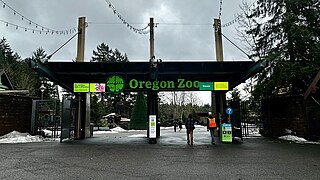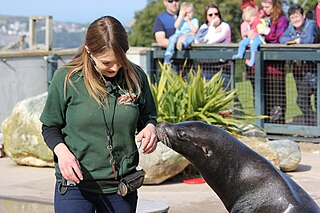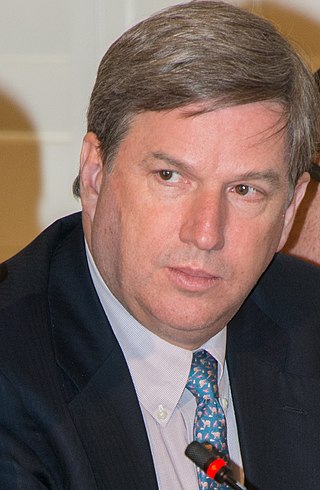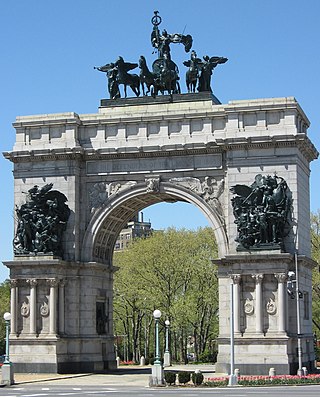
The Bronx Zoo is a zoo within Bronx Park in the Bronx, New York. It is one of the largest zoos in the United States by area and is the largest metropolitan zoo in the United States by area, comprising 265 acres (107 ha) of park lands and naturalistic habitats separated by the Bronx River. On average, the zoo has 2.15 million visitors each year as of 2009. The zoo's original permanent buildings, known as Astor Court, were designed as a series of Beaux-Arts pavilions grouped around the large circular sea lion pool. The Rainey Memorial Gates were designed by sculptor Paul Manship in 1934 and listed on the National Register of Historic Places in 1972.

Jamaica Bay Wildlife Refuge is a wildlife refuge in New York City managed by the National Park Service as part of Gateway National Recreation Area. It is composed of the open water and intertidal salt marshes and wetlands of Jamaica Bay. It lies entirely within the boundaries of New York City, divided between the boroughs of Brooklyn to the west and Queens to the east.

Brooklyn Botanic Garden (BBG) is a botanical garden in the borough of Brooklyn in New York City. The botanical garden occupies 52 acres (21 ha) in central Brooklyn, close to Mount Prospect Park, Prospect Park, and the Brooklyn Museum. Designed by the Olmsted Brothers, BBG holds over 14,000 taxa of plants and has over 800,000 visitors each year. It includes a number of specialty gardens, plant collections, and structures. BBG hosts numerous educational programs, plant-science and conservation, and community horticulture initiatives, in addition to a herbarium collection.

Prospect Park is a 526-acre (2.13 km2) urban park in the New York City borough of Brooklyn. The park is situated between the neighborhoods of Park Slope, Prospect Heights, Prospect Lefferts Gardens, Flatbush, and Windsor Terrace, and is adjacent to the Brooklyn Museum, Grand Army Plaza, and the Brooklyn Botanic Garden. With an area of 526 acres (213 ha), Prospect Park is the second-largest public park in Brooklyn, behind Marine Park. Designated as a New York City scenic landmark and listed on the National Register of Historic Places, Prospect Park is operated by the Prospect Park Alliance and NYC Parks.

The Oregon Zoo, originally the Portland Zoo and later the Washington Park Zoo, is a zoo located in Washington Park, Portland, Oregon, approximately 2 miles (3.2 km) southwest of downtown Portland. Founded in 1888, it is the oldest zoo west of the Mississippi River.

The Brooklyn Museum is an art museum in the New York City borough of Brooklyn. At 560,000 square feet (52,000 m2), the museum is New York City's second largest and contains an art collection with around 500,000 objects. Located near the Prospect Heights, Crown Heights, Flatbush, and Park Slope neighborhoods of Brooklyn, the museum's Beaux-Arts building was designed by McKim, Mead & White.

Luna Park was an amusement park that operated in the Coney Island neighborhood of Brooklyn in New York City, United States, from 1903 to 1944. The park was located on a site bounded by Surf Avenue to the south, West 8th Street to the east, Neptune Avenue to the north, and West 12th Street to the west. Luna Park was located partly on the grounds of the small park it replaced, Sea Lion Park, which operated between 1895 and 1902. It was the second of the three original, very large, iconic parks built on Coney Island; the others were Steeplechase Park and Dreamland. At Coney Island's peak in the middle of the 20th century's first decade, the three amusement parks competed with each other and with many independent amusements.

The Queens Zoo is an 11-acre (4.5 ha) zoo at Flushing Meadows–Corona Park in Queens, New York City, between Grand Central Parkway and 111th Street. The zoo is managed by the Wildlife Conservation Society and is accredited by the Association of Zoos and Aquariums (AZA). Built along with the Queens Zoo is a children's zoo, which was originally called the Heckscher Children's Farm.

The Central Park Zoo is a 6.5-acre (2.6 ha) zoo located at the southeast corner of Central Park in New York City. It is part of an integrated system of four zoos and one aquarium managed by the Wildlife Conservation Society (WCS). In conjunction with the Central Park Zoo's operations, the WCS offers children's educational programs, is engaged in restoration of endangered species populations, and reaches out to the local community through volunteer programs.

Bronx Park is a public park along the Bronx River, in the Bronx, New York City. The park is bounded by Southern Boulevard to the southwest, Webster Avenue to the northwest, Gun Hill Road to the north, Bronx Park East to the east, and East 180th Street to the south. With an area of 718 acres (2.91 km2), Bronx Park is the eighth-largest park in New York City.

The Wildlife Conservation Society (WCS) is a global 501(c)(3) non-governmental organization headquartered at the Bronx Zoo in New York City, that states its mission as saving "wildlife and wild places across the globe". Founded in 1895 as the New York Zoological Society (NYZS), the global conservation organization is, as of April 2, 2024, led by Interim President and CEO Robb Menzi. WCS manages four New York City wildlife parks in addition to the Bronx Zoo: the Central Park Zoo, New York Aquarium, Prospect Park Zoo and Queens Zoo. Together these parks receive 4 million visitors per year. All of the New York City facilities are accredited by the Association of Zoos and Aquariums (AZA). WCS has a global program doing conservation work on the ground in more than 50 countries.

The Prospect Park station is an express station on the BMT Brighton Line of the New York City Subway. It is located in between Lincoln Road, Lefferts Avenue, Empire Boulevard, Ocean Avenue and Flatbush Avenue in Flatbush, Brooklyn, near the border of Crown Heights. Prospect Lefferts Gardens, which is a subsection of Flatbush, is adjacent to the station. The station, which serves Prospect Park and Brooklyn Botanic Garden, is served by the Q train and Franklin Avenue Shuttle at all times and by the B train on weekdays.

The New York Aquarium is the oldest continually operating aquarium in the United States, located on the Riegelmann Boardwalk in Coney Island, Brooklyn, New York City. It was founded at Castle Garden in Battery Park, Manhattan, in 1896, and moved to Coney Island in 1957. The aquarium is operated by the Wildlife Conservation Society (WCS) as part of its integrated system of four zoos and one aquarium, most notably the Bronx Zoo. It is accredited by the Association of Zoos and Aquariums (AZA). As part of WCS, the aquarium's mission is to save wildlife and wild places worldwide through science, conservation action, education, and inspiring people to value nature.

A zoo is a facility in which animals are kept within enclosures for public exhibition and often bred for conservation purposes.

The Lefferts Historic House is located within Prospect Park in Brooklyn, New York City. Built circa 1783, it is the former home of enslaved persons and the family of Continental Army Lieutenant Pieter Lefferts. It currently operates as a museum of the Leffertses' family life in Kings County. The museum is part of the Historic House Trust, owned by the New York City Department of Parks and Recreation and operated by the Prospect Park Alliance. It is a New York City designated landmark.

The National Zoological Park is a 176-acre (71 ha) zoo in New Delhi, India.

Cristián Samper is a Colombian-American tropical biologist specializing in conservation biology and environmental policy. He is the Managing Director and Leader of Nature Solutions at the Bezos Earth Fund. He served as President and CEO of WCS from 2012 to 2022. He was the Director of the Smithsonian Institution's National Museum of Natural History, the world's largest natural history collection, from 2003 to 2012, and served as acting Secretary of the Smithsonian from 2007 to 2008, the first Latin American to hold the position. In April 2015, Samper was inducted into the American Academy of Arts and Sciences.

The Soldiers' and Sailors' Arch is a triumphal arch at Grand Army Plaza in Brooklyn, New York, United States. Designed by John Hemenway Duncan and built from 1889 to 1892, the arch commemorates American Civil War veterans. The monument is made of granite and measures 80 feet (24 m) tall, with an archway opening measuring 50 feet (15 m) tall and 35 feet (11 m) wide. The arch also includes spandrels by Philip Martiny, equestrian bas-reliefs by Thomas Eakins and William Rudolf O'Donovan, and three sculptural groups by Frederick MacMonnies. It is one of New York City's three major triumphal arches.

Pattycake, also known as Patty Cake was a female western lowland gorilla born to Lulu and Kongo at the Central Park Zoo in New York City. She was the first baby gorilla successfully born in captivity in New York. Months after her much publicized birth, Pattycake's arm was broken when it got stuck in her cage as her mother grabbed her away from her father. The incident was sensationally anthropomorphized in the media as a domestic dispute between Lulu and Kongo, but in reality experts thought it was a simple accident.

Flaco was a male Eurasian eagle-owl who escaped his long-time enclosure at Central Park Zoo in New York City after someone cut the protective netting in February 2023. Flaco subsequently resided in and around Central Park. His escape attracted significant public and press attention, especially as he was of a species not native to North America. There were concerns for his ability to feed himself after being captive for so long, since he had not previously needed to fly or hunt, but he was seen successfully catching and eating rats a week after his escape. Attempts to recapture Flaco failed, and a petition circulated advocating that he remain free. Zoo officials ceased attempts to recapture him once it became clear he was eating on a regular basis and his flying skills improved.





























